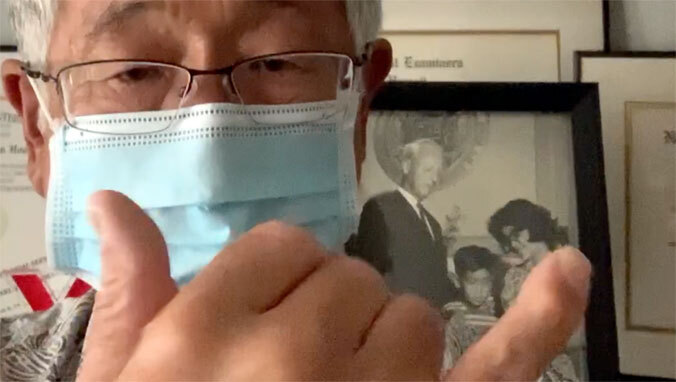
A team of Hawaiʻi researchers led by the University of Hawaiʻi at Mānoa John A. Burns School of Medicine (JABSOM) have come up with a gesture sequence to encourage people to wear their mask correctly in public.
Point your index finger towards your own mask, and then move your index finger up and down, without touching your mask, according to the researchers who published their work in the latest issue of Hawaiʻi Journal of Health & Social Welfare.
Then, throw them a shaka.
“Always follow this by giving them a shaka right away,” said Kasey Tamamoto, lead author of the new study and a JABSOM third-year MD student. The follow-up shaka is important because Tamamoto and her colleagues intend the gesture to be friendly and non-confrontational.
The idea for the gesture came about after the researchers conducted a study of the mask-wearing public on Oʻahu. They collected data in downtown Honolulu and Waikīkī. Results showed 88 percent of people observed in downtown Honolulu were wearing face masks correctly, compared with just 66 percent of people in Waikīkī.
To wear a face mask correctly, it is important for the mask to cover both the nose and the mouth, researchers said.
“Our results suggest there are opportunities to improve rates of public face mask use on Oʻahu, which could decrease the spread of COVID-19 on the island,” Tamamoto said. In total, 23 percent of people observed in the study either wore a mask incorrectly, or did not wear one at all.
More public health education needed
The researchers also said their results show that public health education efforts should be increased. More information should be delivered through social media platforms, perhaps featuring local athletes and social media influencers, they suggested in their study. Education could also be delivered during airplane flights to Hawaiʻi. In public places, people should be encouraged to wear masks even while exercising.
In addition, more research is needed to measure mask use in Hawaiʻi, the researchers wrote.
“A change in our mental model of face mask use may be one of our most effective tools in combating the recent dramatic increase in SARS-CoV-2 infections,” Tamamoto said.
Tamamoto’s co-authors include fellow JABSOM medical student Nikki Rousslang; Hyeong Jun Ahn, professor of quantitative health science at JABSOM; retired pharmacist Heidi Better; and Robert Hong, professor of medicine at JABSOM.
—By Karen Rowan

